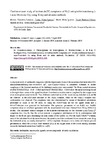Mostrar o rexistro simple do ítem
Conformational study of lanthanide(III) complexes of N-(2-salicylaldiminatobenzyl)-1-aza-18-crown-6 by using X-ray and ab initio methods
| dc.contributor.author | González-Lorenzo, Marina | |
| dc.contributor.author | Platas-Iglesias, Carlos | |
| dc.contributor.author | Mato-Iglesias, Marta | |
| dc.contributor.author | Esteban-Gómez, David | |
| dc.contributor.author | Blas, Andrés de | |
| dc.contributor.author | Rodríguez-Blas, Teresa | |
| dc.date.accessioned | 2020-04-01T12:00:10Z | |
| dc.date.available | 2020-04-01T12:00:10Z | |
| dc.date.issued | 2008-02-21 | |
| dc.identifier.citation | M. González-Lorenzo, C. Platas-Iglesias, M. Mato-Iglesias, D. Esteban-Gómez, A. de Blas, T. Rodríguez-Blas, Conformational study of lanthanide(III) complexes of N-(2-salicylaldiminatobenzyl)-1-aza-18-crown-6 by using X-ray and ab initio methods, Polyhedron. 27 (2008) 1415–1422. https://doi.org/10.1016/j.poly.2008.01.004. | es_ES |
| dc.identifier.issn | 0277-5387 | |
| dc.identifier.uri | http://hdl.handle.net/2183/25285 | |
| dc.description.abstract | [Abstract] A structural study of lanthanide complexes with the deprotonated form of the monobracchial lariat ether N-2-salicylaldiminatobenzyl-aza-18-crown-6 (L4) (Ln = La(III)–Tb(III)) is presented. Attempts to isolate complexes of the heaviest members of the lanthanide series were unsuccessful. The X-ray crystal structures of [Pr(L4)(H2O)](ClO4)2 · H2O · C3H8O and [Sm(L4)(H2O)](ClO4)2 · C3H8O show the metal ion being bound to the eight donor atoms of the ligand backbone. Coordination number nine is completed by the oxygen atom of an inner-sphere water molecule. Two different conformations of the crown moiety (labelled as A and B) are observed in the solid state structure of the Pr(III) complex, while for the Sm(III) complex only conformation A is observed. The complexes were also characterized by means of theoretical calculations performed in vacuo at the HF level, by using the 3-21G∗ basis set for the ligand atoms and a 46 + 4fn effective core potential for lanthanides. The optimized geometries of the Pr(III) and Sm(III) complexes show an excellent agreement with the experimental structures obtained from X-ray diffraction studies. The calculated relative energies of the A and B conformations for the different [Ln(L4)(H2O)]2+ complexes (Ln = La, Pr, Sm, Ho or Lu) indicate a progressive stabilization of the A conformation with respect to the B one upon decreasing the ionic radius of the Ln(III) ion. For the [Ln(L4)(H2O)]2+ systems, most of the calculated bond distances between the metal ion and the coordinated donor atoms decrease along the lanthanide series, as usually observed for Ln(III) complexes. However, our ab initio calculations provide geometries in which the Ln–O(5) bond distance [O(5) is an oxygen atom of the crown moiety] increases across the lanthanide series from Sm(III) to Lu(III). | es_ES |
| dc.description.sponsorship | Ministerio de Educación y Ciencia; CTQ2006-07875 | es_ES |
| dc.language.iso | eng | es_ES |
| dc.publisher | Elsevier | es_ES |
| dc.relation.uri | https://doi.org/10.1016/j.poly.2008.01.004 | es_ES |
| dc.rights | Atribución-NoComercial-SinDerivadas 3.0 España | es_ES |
| dc.rights.uri | http://creativecommons.org/licenses/by-nc-nd/3.0/es/ | * |
| dc.subject | Lanthanides | es_ES |
| dc.subject | Macrocyclic ligands | es_ES |
| dc.subject | Crown compounds | es_ES |
| dc.subject | Ab initio calculations | es_ES |
| dc.title | Conformational study of lanthanide(III) complexes of N-(2-salicylaldiminatobenzyl)-1-aza-18-crown-6 by using X-ray and ab initio methods | es_ES |
| dc.type | info:eu-repo/semantics/article | es_ES |
| dc.rights.access | info:eu-repo/semantics/openAccess | es_ES |
| UDC.journalTitle | Polyhedron | es_ES |
| UDC.volume | 27 | es_ES |
| UDC.issue | 5 | es_ES |
| UDC.startPage | 1415 | es_ES |
| UDC.endPage | 1422 | es_ES |
Ficheiros no ítem
Este ítem aparece na(s) seguinte(s) colección(s)
-
GI-REACT! - Artigos [113]






